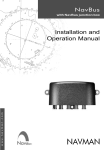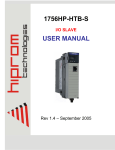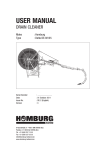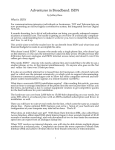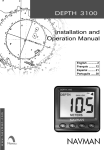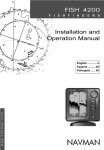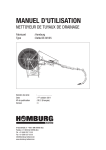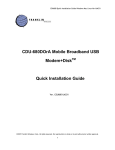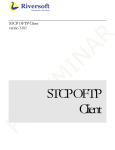Download Adventures in Broadband: ADSL in Bangkok
Transcript
ADVENTURES IN BROADBAND: ADSL IN BANGKOK by Jeffrey Race Part One: What It Is and How to Get It Previous articles in this series on broadband connectivity explored ISDN, a highly cost-effective medium for both home and small business users and for many larger enterprises. (The ISDN series is available for download--see the resource box.) This and the next article will now explore ADSL, a second promising alternative currently being heavily promoted in Bangkok and reportedly soon to be available in the provinces as well. ----PART ONE SIDEBAR 1------------DSL PROVIDERS IN BANGKOK------------------PROVIDER NETWORK URL TELEPHONE Lenso Datacom TOT <www.qnet.co.th> 02 377-0555 Samart TOT <www.samartdsl.com> 02 502-6610 TOT TOT [pending creation] UBT/UCOM TOT <www.ucom.co.th/online> 02 953-1111 TelecomAsia (TA) TA <www.tabroadband.com> 02 900-9000 <www.telecomasia.co.th/taexpress> 02 500-8082/4 ---------------------------------------------------------------------------------PART ONE SIDEBAR 2------------ISPs supporting DSL access in Bangkok-----PROVIDER URL TELEPHONE/TARGET MARKET/REMARK ANET <www.anet.net.th> 02 861-1555 Asia Infonet <www.asianet.co.th> 02 641-1800 CS <www.cscoms.com> 02 596-5000 KSC <www.ksc.net.th> 02 576-0899, 02 979-7000 Loxinfo <www.loxinfo.co.th> 02 263-8222 Pacific <www.pacific.net.th> 02 618-8888 Partner with UBT Promote corporate customer only Reach <www.reach.net.th> 02 637-3000 Formerly C&W ----------------------------------------------------------------------------- 1 ---------------PART ONE SIDEBAR 3------RESOURCES ON THE WEB------------------ISDN article download <www.camblab.com/nugget/nugget.htm> The DSL Sourcebook describes evolution of 120-year old copper telephone network and its adaptation to DSL technology; varieties of DSL and of network configurations; DSL-based services and applications, protocols, security and authentication (100 pages): <www.paradyne.com/sourcebook_offer/index.html> ADSL Forum Web Site <www.adsl.com> ============================================================================== WHAT IS DSL DSL like ISDN utilizes special equipment at the telephone company Central Office (for TOT) or Concentrator (for TA) and at the subscriber premise, to transfer data using only ones and zeroes, unlike ordinary phone lines which use continuously varying voltages. Digital transmission and relatively short lines permit very high data transmission rates. Unlike ISDN however, the DSL variant now being promoted in Bangkok (called ADSL) allows use of both phone line and full-bandwidth data transmission simultaneously. (ISDN allows up to 128 kb/s but each telephone conversation consumes 64 kb/s so one phone call means only 64 kb/s is available for data.) The Central Office or Concentrator requires a special device called a DSLAM (Digital Subscriber Line Access Multiplexer), and the customer premise (located no more than 3-5 km from the DSLAM depending on cable gauge and required service speed) requires a line splitter (filter) and an ADSL terminal adapter (generally misnamed "modem") as shown in the accompanying illustration. Also, the subscriber ’s inside building wiring must be in very good condition; the test setup used for this article failed for several hours after a rainstorm due to moisture infiltrating the inside wiring! 2 BENEFITS/DISADVANTAGES ADSL provides important download/upload speed advantages compared to analog dialup, and also in some cases compared to ISDN if ADSL’s higher rate options are selected. It is less expensive than leased-line service at some sacrifice in reliability. Currently download speeds are available in commercial packages up to 1,000 kb/s and you can simultaneously use the phone line. (SDSL permits even higher speeds but does not allow simultaneous line use for phone service.) You may keep your existing phone number and even (on a TA line) simultaneously enable PCT. Once installed ADSL service is instantly available, so you need not wait for handshaking as is the case (sometimes up to a minute) with analog dialup. If you use an ADSL modem on an hourly plan, click on the connection icon to be instantly online. With unlimited service using a commercial plan and a router, applications such as mail clients and browsers are always connected. This "always on" capability is however a two-edged sword: since you are always live, you need protection against malicious net users, and there are plenty. Within a few minutes of establishing an ADSL connection your computer will see probes, some benign and some hostile. If you do not install a software or hardware firewall your computer is at grave risk, especially if you are running Windows, any of several Microsoft applications, or unsecured Linux. PRICING Many metrics apply to pricing comparisons so for the purpose of comparison with other service options, two ADSL packages are shown. The metrics are: - hourly charge vs unlimited - dedicated vs shared bandwidh - fixed vs dynamic IP address - DSL media fees vs ISP fees - Install fees - Hardware rentals or acquisition costs The package permutations are constantly changing due to market conditions so be sure to explore current offers of all providers available in your service area. This presentation is indicative only and is not intended to recommend or exclude any providers. 3 -----PART ONE SIDEBAR 4----------INDICATIVE PRICING BY PACKAGE--------------PACKAGE Single user home user SOHO Shared bandwidth* 128 d/l 64 u/l Dynamic IP Hourly fee PROVIDER MEDIA/UNIT (bht) TA ISP/UNIT (bht) ---bundled-----------------> TOT concessionaires 1,000 TOTAL (bht) REMARK "HomePak" promotion incremental 26 bht/hr 1,552 (40 hrs) 2,000/100 hrs 3,000 UBT+Anet promotion * guaranteed 20% of rated throughput Subscriber pays installation fee and buys modem (6,000-9,000 baht) Enterprise Dedicated bandwidth* 256/128 Fixed IP Unlimited service -------------------------------------- ---- --TA 6,800 29,000 35,800 TOT concessionnaire 6,200 20,000 26,200 "BizPak" promotion (with AI, Anet or KSC) * guaranteed 100% of rated throughput Media providers will generally install at no charge and provide rent-free equipment such as Nokia M1122 Router (market price 15,000-23,000 baht) ------------------------------------------------------------------------------------------------------------------We can see from this comparison that the single-user packages now on offer are very good values, possibly not even economic for the providers. Subject to the caveats in the second part of this series, if your time is worth anything, the current promotions (requiring a one-year contract) are very attractive. TA even offers its own ISP (Asia Infonet) as part of a bundle for less than offered unbundled to TOT concessionnaire customers. If you need a fixed IP address e.g. for a company Virtual Private Network, then ADSL becomes quite expensive, though cheaper than leased-line service. Due to the anomalously low promotional pricing of the small user packages, some providers have ceased to serve this market, complaining that their experience is the "home users" generate higher traffic than enterprise customers paying five or ten times more. (They are probably internet cafes or small businesses who have connected their own bridges.) 4 WHO CAN GET DSL If you want DSL your first step is discovering who offers in your geographic area. At the moment service is available only in selected areas of Bangkok, and nowhere upcountry. (TOT plans DSL in the provinces in the fullness of time. TT&T previously announced likewise in its service area but attempts to verify a rollout date were unsuccessful by press time.) Intending subscribers must have their telephone service from a DSL-enabled telephone Concentrator (TelecomAsia) or Central Office (TOT concessionaire) and be within the distance limit imposed by the very high frequency of the DSL signals. In addition the service cable must be in good physical condition. You can contact each of the DSL media providers to enquire whether your exchange number is DSL-qualified (some have query engines on their websites--try first: it’s fast). Currently TOT and its concessionaires cover about 40 Bangkok telephone Central Offices (the coverage patterns differ) and TA, with a different distribution system using Remote Concentrators served over fiber optic lines, covers a large area of Bangkok as well. If your TOT number is not DSL-qualified, a new TA number might qualify. If more than one provider is possible, then choose based on pricing, availability of a plan to fit your needs (for example, some providers offer only high-end enterprise packages) and reliability/service. Here TA has a slight advantage because its newer distribution system is in better physical condition than TOT’s, an important factor in high-speed transmission. Also, DSL service from a TOT concessionaire may involve two cooks in the kitchen in many trouble-shooting exercises. TA on the contrary controls its complete network so is able to fix cable problems seven days a week with its own staff. However TOT now provides seven-day-a-week maintenance of DSL lines as well, a welcome result of the growing competitiveness in the Thai telecom sector. Next week we will review installation issues, hardware and software, and tweaking for a perfect installation. 5 ------------------PART TWO: ADSL Hardware and Software-------------------------------In this concluding DSL article we cover a number of hardware, software and installation issues, platform tweaking and testing, and conclusions. Sources of all items mentioned in the text are detailed in the resource box. Future articles are planned to cover applications such as videoconferencing and VoIP, and other broadband alternatives to ISDN and DSL. Hardware for Individual Users Windows Individual users have two easy choices, either PCI card DSL terminal adapters (for desktop systems) or USB DSL terminal adapters for desktop or notebook machines. Devices are available from a variety of vendors currently in the 6,000-9,000 baht price range, and single-user accounts have to provide on their own or take up a bundled device from the DSL media provider. Dialing in to the DSL media provider requires Windows’ DUN function as well as PPPoE dial software. The popular RASPPPoE shareware package is available as shown in the resource box and includes an excellent help file. Installation is fast and trouble-free. Experienced installers note that PCI and USB terminal adapters provide less stable DSL connections since they rely on drivers in the host OS. While inexpensive they cause problems so if time is money for you, a better choice is an external bridge or router which offloads the connectivity tasks from the OS to internal firmware. UBT has reportedly entirely dropped USB, offering individual users only an OEM PCI card. Many USB devices have no WinNT support. Note that Bangkok’s ADSL offerings differ in some ways from those of other countries and not all hardware will work here with all DSL media providers (whose technology indeed differs one from the other). For example the popular and highlyrated Linksys router works out-of-box with TA DSL service because the TA network detects the VPI and VCI of connected devices, but fails with UBT and Lenso networks unless manually configured. Barracuda, SMC and USR devices all also fail with these networks. Only the ZyXel Prestige 642R adapter/router will work with TA Express. These devices are expensive in Thailand so ensure that any contemplated hardware is compatible with the intended DSL media provider. A good independent resource to check with is ADSLThailand. Apple The MAC OS X includes native USB and PPPoE support so setup is easy. Earlier versions can use enternet100.hqx per details in the resource box. Linux USB drivers may be available for some DSL adapters but support is more likely available for PCI card DSL adapters or Ethernet cards to connect to a bridge or router. Robust PPPoE for Linux has been tested to work on the TelecomAsia ADSL service and an alternative is NTS100LINUX. In preparing this article a SuSE demo booted up a default install and the PC Card NIC (connected to a router) worked immediately without any configuration whatever. It was even easier than Windows. 6 OS/2 users must install the included MPTS and TCP/IP modules and will have to update MPTS to run DHCP since the MPTS version included with OS/2 install disks includes a fatal bug. No USB drivers are available so OS/2 users must utilize a PCI card DSL adapter or Ethernet PC Card NIC via RJ-45 cable to a bridge or router. Many different PPPoE dialers are available which include as well a variety of other functions including firewalls. For a router select DHCP in TCPCFG; for a bridge select Fixed IP adress in TCPCFG and use a PPPoE dialer. IFCONFIG will configure the network interface, NETSTAT will report its condition, and DHCPMON will monitor the lease. Hardware for Groups and Enterprises DSL media providers currently may bundle bridges and routers with their services, and provide free installation, configuration and maintenance with their enterprise offerings. Users are permitted to source their own hardware though discouraged from doing so as this complicates testing from the DSL provider ’s Network Operations Center. (Now the NOC can telnet into a bridge or router and query/reconfigure/reset it.) Enterprise installations contracting for unlimited/continuously-on service will employ a router and probably have a fixed IP address which can be used to establish an enterprise Virtual Private Network and/or VoIP system. Looking to the future TA has DIFFSERVE capability (a Quality of Service function enhancing VoIP ) but it has not yet implemented. Now every packet has the same priority resulting in choppy voice transmission. A USA site detailed in the resource box contains a variety of product reviews useful to local DSL subscribers. Software Utilities, Testing and Tweaking Many resources exist to enhance DSL operation. Tools and utilities For monitoring any connection under Windows including dialup, ISDN, DSL or cable, the premier tool is MyVitalAgent, formerly NetMedic, a free download. Similar shareware tools under OS/2 are IPMonitor and IPSpeed. Security You need it; don’t connect your DSL line until you have a firewall installed or you will be sorry, especially if you are running Windows or unsecured Linux! The most popular Windows software firewall for individual users (because it is free and a no-brainer to use) is ZoneAlarm. Equally free but more configurable (and capable) is the Tiny Personal Firewall. Linux and OS/2 have comparable utilities. A better alternative is to configure a router as a firewall. 7 Tweaking, Testing and Troubleshooting Several sites listed in the resource box offer a variety of tools to test the speed of your connection and to suggest tweaks to your computer’s configuration to speed its performance. Don’t fail to test and tweak your setup because improvement can be substantial. If you are having troubles installing, or using, a DSL connection you may want to read RFC 2516 which defines the PPPoE protocol, then use logging software to record sessions and compare them with the standards. This procedure was employed with critical effect twice in preparation of this series, once to debug a PPPoE dialer, and once to determine why a local ISP was suddenly rejecting all outgoing mail. (They had just "upgraded" their mail server configuration!) Installation issues If you are in a suburban or other high-lightning area be sure that the protector on the phone line serving up your DSL circuit is properly grounded . You may also want to provide additional protection to your expensive DSL adapter, bridge or router by using the Off Premise Multi-Protector now locally available from Goham Co. Ltd. It’s a few hundred baht well invested, superior to the devices used by TOT and TelecomAsia, and may prevent your expensive hardware from frying in the first electrical storm. Also ensure that bridges and routers are properly grounded at the ac power receptacle. The Nokia router tested in preparation of this article curiously did not include the mandatory ground pin specified at page 6 of its own User Manual. Check yours! Also recheck to verify you have grounded your computer using its third (ground) power pin (the one the installer broke off). Finally, if you will be using your DSL service for mission-critical work, develop a backup power plan using an Uninterruptible Power Supply. Conclusions For technical reasons such as volume of traffic, required transmission speed or need for a fixed IP address, some subscribers may require DSL. However those with less stringent requirements face a realistic choice between ISDN and DSL. First, it should be noted that DSL’s high download speeds (the first number quoted in the pricing packages (e.g. the "256" in 256/128) are effective only for sources within Thailand. In preparing this article testing of offshore downloads typically resulted in speeds of 73-100 kilobits/second (which shows as about 9-13 kilobytes/second in the monitor utilities) depending on time of day, less than the channel bandwidth. Downloads within Thailand achieved the contracted bandwidth. Spokesmen for both TOT and TA confirm that the real commercial potential of DSL for many potential customers will be achieved only when local content such as music and video becomes available. Both are presently cooperating with other firms to develop such local content. Thus users mainly communicating locally will benefit more from DSL than those linking offshore for large file transfers. 8 The other side of this equation is the ISDN pricing anomaly noted in a previous article. Other countries charge for ISDN transmission by byte throughput or occasionally by time online, while in Thailand only a 3-baht call setup fee is charged even if the connection is held up for a month. Thus many users will still find ISDN a better choice especially if they are downloading large files from abroad (they get no benefit from DSL) or they make file transfers locally with other ISDN users for which no ISP time charges apply. /END/ ---------PART TWO--SIDEBAR ONE------Resources on the web-------------------Source-agnostic DSL hardware vendor, installer and consultant <www.adslthailand.com> Telephone 02 570-4180 Dialers RASPPPoE Windows Dialer for USB and PCI stand-alone DSL modems <http://user.cs.tu-berlin.de/~normanb/> Apple PPPoE driver Enternet100.hqx <http://support.acsalaska.net/download.html> Robust PPPoE for Linux tested to work on TelecomAsia ADSL service <www.roaringpenguin.com/pppoe/> NTS100LINUX <http://support.acsalaska.net/download.html> EnterNet for Linux FAQ <http://support.efficient.com/KB/NTS/linux.html> OS/2 dialer and firewall <www.lgs.kiev.ua/products/sffw.shtml> OS/2 dialer with ISDN CAPI 1.2/2.0, DSL (PPPoE) and modem supportas well as support for cable modems with NAT, IP-Masquerading, Dial-, Timeoutand Packetfilter, Dial-In Server functionality (shareware) <www.isdnpm.de> or <www.mensys.nl/isdn/> OS/2 DSL and ISDN dialer <www.cfos.com> InJoy multi-media, multi-platform dialer and firewall <www.fx.dk> 9 Speed testing facilities and utilities Article on DSL speed testing: <http://compnetworking.about.com/cs/speedtests/> Testing servers in multiple geographic areas: <www.testmyspeed.com> Calibrated 5 mb test file from known good server <ftp://service.boulder.ibm.com/test.5mb> Network equipment product reviews <www.practicallynetworked.com> Category 5 patch cable configuration and construction <www.siemon.com/standards/comm_config.asp> <www.atcomservices.com/highlights/makepatch.htm> Microsoft Knowledgebase "How to Configure ICS for Use with DSL Connections That Use PPPoE Adapters" <http://support.microsoft.com/support/kb/articles/Q273/5/87.ASP> "Windows 98 SE Problems with NDIS Intermediate Drivers" <http://support.microsoft.com/support/kb/articles/Q243/1/99.ASP> Tips, tweaks and patches <www.dslreports.com/tweaks> <www.speedguide.net> <www.webattack.com> Circuit performance monitor utilities MyVitalAgent 8.01 (formerly NetMedic) for Windows <www.downloads.com> (reviewed in the Bangkok Post at <http://scoop.bangkokpost.co.th/bkkpost/2001/april2001/db040401/040401_database14.html>) IPMonitor V 103 for OS/2 <http://hobbes.nmsu.edu/cgi-bin/hviewer?sh=1&fname=/pub/os2/util/network/tcpip/ipmon103.zip> IPSpeed for OS/2 <http://hobbes.nmsu.edu/pub/os2/util/network/tcpip/ipspeed4.zip> Review article <www.os2voice.org/VNL/past_issues/VNL0199H/vnewsf5.htm> 10 Off-Premise Multi-Protector Datasheet at: <www.camblab.com/consumer/opmp_ug1.pdf> (manufactured in Thailand by Goham Co. Ltd, Telephone 02 279-6162 e-mail [email protected]) Firewalls ZoneAlarm <www.zonelabs.com> Tiny Personal Firewall, more complex setup but gives more control than ZoneAlarm <www.tinysoftware.com> Firewall testing Gibson Research <www.grc.com> TCP/IP connection logger Windows and Linux (GNU freeware) <www.ethereal.com> Windows <www.westbrooksoftware.com> OS/2 Use IPTRACE included with OS/2, or the trace utility built into ISDNPM Networking guides for establishing DSL connections via ethernet <www.helmig.com/j_helmig/guide.htm> <www.os2ezine.com/v1n14/socks.htm> <www.os2ezine.com/v2n7/warpwin.htm> <www.phillyos2.org/networking.htm> <www.macwindows.com> Update OS/2 MPTS <www.warpupdates.de/english/warpupdates.html> RFC 2516 <www.ietf.org/rfc/rfc2516.txt?number=2516> Copyright © 2002 by Jeffrey Race All rights reserved 11











